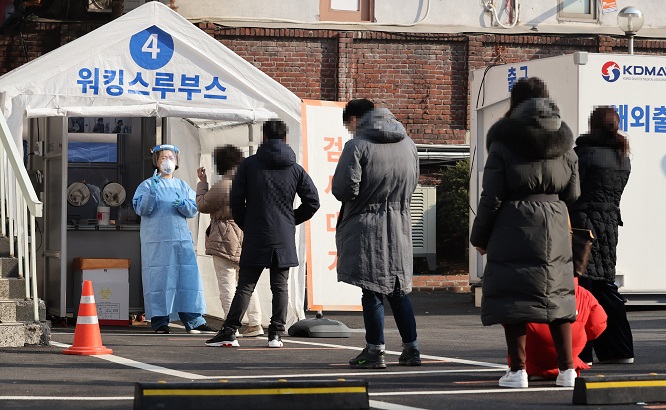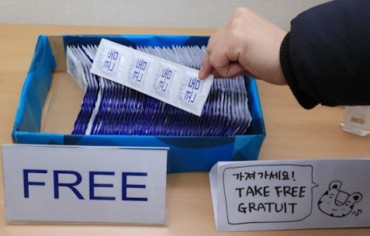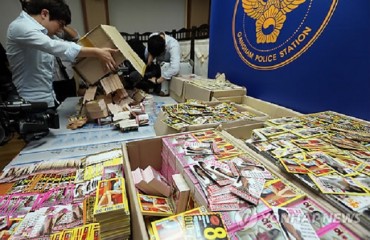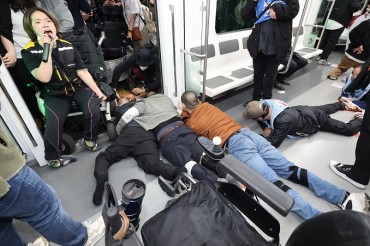
A vehicle enters the central vaccination center set up in the National Medical Center in Seoul on Feb. 21, 2021, as South Korea plans to start the COVID-19 vaccination program on Feb. 26. (Yonhap)
SEOUL, Feb. 21 (Korea Bizwire) — South Korea’s daily new coronavirus cases stayed below 500 for the second straight day on Sunday, but health authorities remained vigilant about a potential flare-up in virus infections amid eased social distancing rules.
The country reported 416 more COVID-19 cases, including 391 local infections, raising the total caseload to 86,992, according to the Korea Disease Control and Prevention Agency (KDCA).
The country added four more deaths, raising the total to 1,557.
The virus tally was lower than 448 reported Saturday and 561 on Friday.
The fall in daily cases appears to be due to fewer virus tests over the weekend.
As of 9 p.m. on Sunday, South Korea reported 295 new cases, 89 fewer than the previous day at the same time.
Of the total, 221 cases came from the greater Seoul area.
The outbreak of cluster infections at workplaces, hospitals and religious facilities has posed challenges to the country’s antivirus efforts amid concerns about the spread of more contagious COVID-19 variants.
After the third wave of the pandemic peaked at a record high of 1,240 on Dec. 25, new virus cases fell to the 300s between Feb. 13-15 due largely to less testing over the Lunar New Year’s holiday.
But COVID-19 cases bounced back above 600 on Wednesday and Thursday, sparking concerns about a flare-up in virus infections amid eased social distancing rules.
On Monday, the country relaxed its virus curbs to Level 2, the third highest in its five-tier scheme, in the greater Seoul area, and Level 1.5 in other regions in an effort to help ease economic pain on smaller merchants.
Health authorities warned of a pickup in virus cases tied to holiday traveling, saying that they could tighten the virus restrictions if the number of new cases swells.
“It is worrisome that the spread of virus transmissions in the greater Seoul area has quickened,” Son Young-rae, a senior health official, said at a press briefing.
“If needed, authorities plan to consider adjusting virus curbs after taking into account this week’s situation.”
Son also noted that the reproduction rate of COVID-19 has reached about 1.1 across the country over the past seven days. The rate measures the number of people an average patient infects, and anything above 1 means the outbreak is spreading.
The reproduction rate during the Jan. 10-16 period sat at 0.79, but has since risen to 0.82, 0.95 and 0.96 for the ensuing seven-day periods.
The government also opened 14 temporary testing stations on Sunday in areas with high concentrations of migrant workers.
Son said these centers, in parts of Seoul, Incheon, Gyeonggi Province and South Chungcheong Province, will offer free tests.
The new testing stations have been set up to address blind spots in the nation’s fight against the virus, Son explained.
Migrant workers, who often live in company dormitories, may be vulnerable to cluster infections but some could be reluctant to get tested because of their illegal status.
Son said the KDCA will hold talks with the justice ministry and the labor ministry on measures to offer anonymous tests for foreigners.
“We’d like to stress that migrant workers will be able to get tested, regardless of their status, and we will not take any legal action against them based on the information that they provided for tests,” Son said.
“We’ve informed employers that these tests will not be used to crack down people who are staying here illegally.”

Citizens wait in line to receive COVID-19 tests at a testing site of the National Medical Center in central Seoul on Feb. 21, 2021. (Yonhap)
South Korea is preparing to revise the current distancing scheme in a way that minimizes one-size-fits-all business shutdowns. Authorities may not be able to implement the new system in March as planned if the current wave is not brought under control.
Of the locally transmitted cases, nearly 80 percent were reported in the greater Seoul area, home to half of the population. Seoul reported 120 additional cases and Gyeonggi Province that surrounds the capital added 170.
Incheon, west of Seoul, identified 21 new cases.
Cases tied to Soon Chun Hyang University Hospital in central Seoul increased by five on-day to 206. Infections traced to a plastic factory in Namyangju, east of Seoul, came to 162, up 14 cases over the past 24 hours.
Cases linked to a Kiturami boiler factory in Asan, 83 kilometers south of Seoul, added five to 170.
The positivity rate, the portion of newly infected people against the daily number of people receiving tests, reached 2.01 percent, up from 1 percent the previous day. The rate topped 2 percent for the first time since Jan. 25.
As of Saturday, health authorities added 20 new cases of more transmissible virus variants, raising the total to 119.
The country will begin the COVID-19 inoculation program with AstraZeneca’s vaccines on Friday, with first jabs to be administered to staff members and patients under the age of 65 at nursing hospitals and facilities.
It will also start to give shots to frontline medical workers with Pfizer’s vaccines on Saturday. The country will receive 117,000 doses, developed by the U.S. pharmaceutical firm, through a global vaccine procurement program later this week.
The country has secured enough coronavirus vaccines to inoculate 79 million people, higher than its population of 51.6 million. It aims to achieve herd immunity by November.
The country, meanwhile, added 25 imported cases, increasing the total to 6,894.
The number of seriously or critically ill COVID-19 patients was 155, down from 156 in the previous day.
The total number of people released from quarantine after making full recoveries stood at 77,516, up 433 from a day earlier.
(Yonhap)






